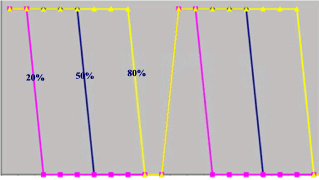The Charge Controller
The Batteries' Protector
The charge controller is “sandwiched” between the solar electric panels (or any other DC source) and the deep cycle batteries. All three together comprise your off grid solar power system.
The Insurance Policy of the Batteries
The controller is the “insurance policy” for the batteries, it insures the batteries are charged in an optimal manner.
What is the reason to have the controller, why a direct connection of the solar panels (or any other DC source) to the batteries is not recommended? (to say the least)
The solar panels (also relevant to small wind DC turbine and microhydro DC turbine) can generate Direct Current (DC) into a load. The operating voltage of the solar panels varies over a pretty wide range. What cause the voltage to vary are the following:
- Sun radiation intensity (sun altitude and presence of clouds)
- Temperature (The lower the temperature the higher the voltage)
- The load current (the more current is drawn the lower is the voltage)
- Voltage changes are also typical to wind DC turbines and hydro DC turbines due to specific reasons
The voltage of the batteries gets lower as the battery discharges and when more current is drawn by the
off-grid inverterCharger Voltage must be higher than the Batteries Voltage
To charge a battery, the charger voltage must be higher than the battery voltage. Therefore, the solar panel minimal specified voltage must be greater than the battery maximal expected voltage. For example, a nominal 12V battery maximum voltage (fully charged) is 12.7V (13.6V while connected to a charger) so the “12V panel” minimum voltage must be greater than that (with design margin it is 16V to 20V)
Now, here is a problem one needs to solve. How do you adopt the voltage range of the solar panels (16V to 20V) to that of the battery (10.7V for discharged battery to 12.7 for fully charged battery)? You certainly don’t want to connect directly the solar panels 20V to the battery. You need some kind of a regulator (I use this term because in the car there is a similar solution for a similar problem). This “regulator” is called (logically I believe) a charge controller.
There are 2 ways to achieve this regulation functionality:
- Use controlled serial resistors on the DC path between the solar panel output to the battery terminal
- Use a smart DC to AC inverter, control the AC voltage, invert back to DC (3 stages)
You might be tempted to use alternative 1 because it is cheaper. However, it is not recommended. Expensive solar panels energy is wasted on heating up resistors. As a consequence you need to increase the solar panels size and to dissipate the produced heat somehow. Eventually you pay much more on larger panels compared to the saving on the charge controller.
Alternative 2 is a bit more expensive however the benefits over weigh the price difference. The controller can be very efficient (96% to 98%, only 2-4% are heat losses). The second benefit is that this approach lends itself to be more flexible
Principle of Operation
How does the controller work? Most of them use pulse width modulation (PWM). PWM AC wave-shape is a controlled asymmetrical rectangular pulse train. I drew a picture bellow to illustrate what I mean

The purple is ON 20% of the time
The blue is ON 50% of the time
The yellow is ON 80% of the time
The PWM varies the ON time according to the desired charge voltage. The higher the ON time, the higher is the voltage.
The last cry in controllers is called MPPT controller. Some might call it 4 stages controller. They are more optimized to do the job and they still use the PWM with some twists.
The MPPT controller
The Maximum Power Point Tracking (MPPT) algorithm is implemented usually by an industrial type digital controller. The MPPT charge controller monitors the momentary output voltage of the solar panels as well as the battery momentary voltage. It then calculate in what direction it needs to change the voltage applied to the battery in order to achieve the optimal condition. Namely, the panel delivers dynamically the maximum power to the battery. This is done repetitively and dynamically until the optimum voltage/current is achieved. A good MPPT controller will dramatically improve the power charging capability of the solar panel/battery combination.
Choosing and Buying a Charge Controller
What is important to see when buying the controller?
- The manufacturer is well known and has a good established reputation
- The input voltage rating matches the solar panel voltage rating
- The output voltage rating matches the batteris you use
- It can provide enough charge current that matches the solar panels current capability
- Efficiency (shoot for 95% or better)
- In case the wires to the battery are long, it has sense inputs
- It is a benefit to have a smart control (micro-controller) and a data communication port but it is not a must
I recommend buying your off-grid solar kit from a reliable "one stop shop" that can fit all the elements to what you need
More Charge Controller Related Reading
What are solar electric panels?
What are deep cycle batteries?
What is an off-grid power system?
click to return from the charge controller page to the off-grid solar page
click here to view my Home Page
